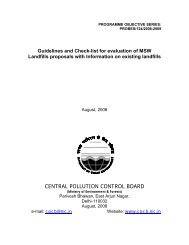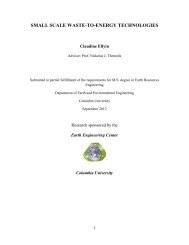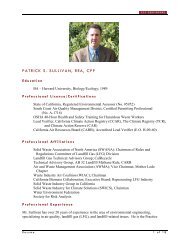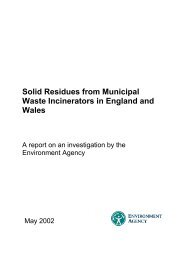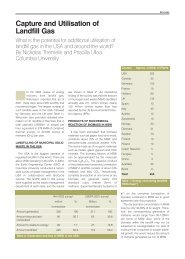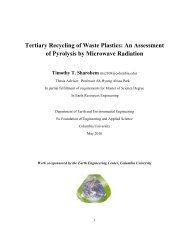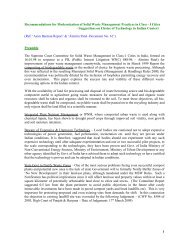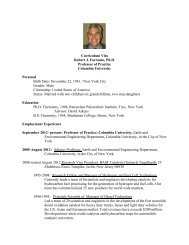Design Review #2 - Columbia University
Design Review #2 - Columbia University
Design Review #2 - Columbia University
Create successful ePaper yourself
Turn your PDF publications into a flip-book with our unique Google optimized e-Paper software.
Shadow Incorporated<strong>Design</strong> <strong>Review</strong> <strong>#2</strong>February 17, 2005Mark BackmanBen CollinsJesus GonzalezSuma TumuluriVinita Venkatesh
Table of ContentsShadow Incorporated<strong>Design</strong> <strong>Review</strong> <strong>#2</strong>Introduction................................................................................................................................................. 3Specifications.............................................................................................................................................. 4Risk Analysis .............................................................................................................................................. 5Parameter Analysis ..................................................................................................................................... 7Final <strong>Design</strong>................................................................................................................................................ 8Product Operation ................................................................................................................................... 8Components ............................................................................................................................................ 9Thrust Calculations ............................................................................................................................... 10Drawings & Calculations...................................................................................................................... 10Information Sources:................................................................................................................................. 11
Shadow Incorporated<strong>Design</strong> <strong>Review</strong> <strong>#2</strong>IntroductionShadow Incorporated has created a product concept to help open water swimmers around theworld. Within the span of one semester, this team will create a working prototype model that can beaccurately tested and used as a foundation for further design. The creation, an autonomous boat thatfollows a swimmer in open water, can later be modified and enhanced in several ways. In terms ofmarketability, this product is quite useful and highly desirable. Currently, open water swimmers musteither tie a buoy to their bodies while swimming under water, or hire a boatman to stay within a certainspecified range of the swimmer to notify boats of his or her presence under water.The main criterion of Shadow Inc.’s product is to be able to follow a swimmer wearing atracking device, while maintaining stability and holding up a regulation sized flag. Features that canlater be added once this model is working include a GPS system to mark the exact location of theswimmer, and a radio system to notify nearby boats via special signal. These ideas can be worked ontothe system following preliminary testing and operation.Rigorous patent searches have not found any products that mimic the design of this product, orany existing products for autonomously following a swimmer. Based on this search, Shadow Inc. ishighly confident that this product is marketable and desirable.Product Conception:Boat & Hull <strong>Design</strong>: The boat will be prototyped before any final design is settled on. The boat’ssize and shape are constrained primarily by the size and weight of the electrical components that it mustcarry, including the battery, microcomputer, dc motors, resistors, and op-amps, as well as byhydrodynamic criteria that it must meet. The boat must be capable of withstanding the weight and dragforces placed on it by the regulation flag that it will bear, as well as the drag of the water’s current, andbe able to maneuver with considerable accuracy. Thus, stability and maneuverability are the two mainfocuses when considering the hull design. Stability is the more vital of the two. A catamaran offersoptimum stability. The boat will be equipped with two propellers attached to two separate dc motors.Having the two propellers, as opposed to just one with a rudder, eliminates the need for a stepper motor,and simplifies the controls quite significantly. With two motors, both motors can simply be turned onwhen the target is directly in front of the boat, and then the speeds of each motor can be varied when theboat needs to be turned in any particular direction.Signal Processing: The swimmer, or target, will carry a transmitter that will send out anultrasonic pulse every x number of seconds. Those signals will, in turn be received by two sensors on
Shadow Incorporated<strong>Design</strong> <strong>Review</strong> <strong>#2</strong>opposite sides of the boat. The difference in time of flight, or the difference in the time it took the pulseto get to each signal, will dictate where and how the boat should turn, or which motor to turn on or off.An alternative could be to simply measure the intensity of the signals. The sensor closer to the swimmerwill have a stronger signal. The last and most promising alternative is to have several sensors pointing inall different locations. The sensors are extremely directional. Measuring only intensity simplifies thelogic quite significantly. Whenever a certain sensor’s intensity increases, the direction of the swimmer isimmediately known and the appropriate motor will turn on. The pulse will be generated with a chip thatwill produce two signals. One signal will be just a pulse, and the other will be a square wave with a 40kHz frequency. When put through an AND gate, the result with be a 40 kHz pulse. When that pulse getsto the boat, the microcomputer will process the difference in time of the signals and steer the boataccordingly. A third sensor will manage orientation and distance from the swimmer. The sensors havebeen tested and noise is a major issue. Active narrow band-pass filters are currently being tested toreduce noise as well as amplify the signal.Control: The sensor outputs will be fed into a microcomputer. This microcomputer will processsignal strength, and/or timing, and will output a Pulse-Width-Modulation signal that will control the twoDC motors in the boat. In this way the boat’s direction and steering will be guided.SpecificationsThe specifications for the current design idea give a clearer image of the details involved in thedesigns of both the boat hull and the electronics. Currently, the prototype takes the shape of a catamaranwith a cross panel that connects two hulls and is 29 inches long and 18 inches wide as its maximum.This is a typical size for model boats and is sufficient for the electronics that must sit atop. Theelectronics will be housed in a waterproof casing on the cross panel and the batteries will sit low in thehull region so as to function as ballast. All contents of the hulls will be coated in a waterproof materialas a precaution for splashing. The two 4” wide hulls will have a pentagonal shaped geometry in the rearthat gently blends to a rounder, smoother front portion of the hull. This displacement hull design willallow for the stability needed to carry the batteries, as well as generate the speed required. Each hullwill have a one-inch propeller at the back which will be controlled to increase or decrease in speed bythe electronics. The propellers will sit at ninety degrees from one another with the fans facing slightlytowards the midline of the boat.Three sensors will be located on the boat body: two attached to rods perpendicular to the rear ofthe hulls so they are completely submerged in water ready to receive ‘ping’ signals from the sensor on
Shadow Incorporated<strong>Design</strong> <strong>Review</strong> <strong>#2</strong>the human being, and one closer to the front. The sensors will be triangulated in order to determine theposition of the swimmer on the surface of the water and the distance from the boat. The sensor will bekept around the swimmer’s waist and will be a piezoelectric transmitter and receiver.transmitter/receive will receive the ‘ping’ signal from the transmitters on the boat, then wait adetermined finite amount of time, and return the signal to the boat. This process allows the boat to knowthe swimmer’s position and use this information to adjust its speed and directional orientation withrespect to the swimmer. An LM555 Timer Semiconductor from National Semiconductor will be used togenerate an accurate time delay that is used to generate a 40 kHz signal.Two motors with a range from 1.5V to 3V (www.cnhsales.com) will be the source of power forthis water vehicle. A pulse width modulator will be used to control the variation of the voltages used topower these motors. This variation of voltage will allow the propellers to steer the boat and adjust thedistance from the swimmer depending on the positional signal that is communicated between the boatand the swimmer. For the prototype hulls, Styrofoam ribbing will be used to create the geometry, andbalsawood will be used to mold the body based on the ribbing’s geometry. This outer balsawood layerwill be roughly 1/16” thick and will be coated with a layer of polyurethane in order to ensure that theboat is waterproof. Ideally in the final version, the boat’s outer layer will be fiberglass. This fiberglassouter layer will guarantee a water tight seal.ThisRisk AnalysisIn designing an autonomous boat there are several risks and problems that are foreseen in thedesign. All of these problems must be dealt with, though some will be less important than others in thedevelopment of a prototype. Safety risks are crucial to marketability of the product, so they will be keptin mind, but will not be the focus in this phase of design. Other foreseeable problems are more urgentwith the prototype and relate directly to functionality.Safety Risks:1. What if the boat runs over the swimmer?a. If there is a collision between the boat and the swimmer, and the propeller hits theswimmer it could result in a cut to the skin.b. The prototype will have an overriding remote control unit, so that a person on landwill have the ability to override the autonomous control, and steer the boat away fromthe swimmer.
Shadow Incorporated<strong>Design</strong> <strong>Review</strong> <strong>#2</strong>c. In a marketable design it may be important to include a safety feature which turns offthe boat automatically when an object is within a certain range.2. What if a swimmer is in distress, and wishes to use the boat for flotation?a. The prototype will most likely not be able to support a swimmer in distress, but afinal product may have space for an inflatable tube, or other form of life savingdevice.b. For the prototype a label that reads “Is not a lifesaving device” will be included inorder to cover liability.Functionality Problems:1. Will the boat be able to turn quickly enough to demonstrate in a pool?a. The longer the boat, the harder it will be to turn.b. Since two propellers angled at 90° will be used together, the boat will go straight, butby varying the speed of one from another the boat will be able to turn.c. For demonstration purposes, pools other than the <strong>Columbia</strong> <strong>University</strong> pool, whichwill restrict the distance the boat will be able to follow the swimmer, will beconsidered. Lehman College has a pool which is over 2 meters deep and 25 metersby 50 meters. This facility will make the final demonstration & test more accurate.2. How can disturbance be reduced for the sensors?a. Surface disturbance, as well as the pool walls and bottom will create noise that willmake it hard to follow the signal on the swimmer.b. The prototype model will have a ping from the swimmer using a chip from NationalSemiconductor that is designed to create a pulse at an accurate time delay. Pingingfrom the swimmer will take out the need for reading reflections, and increase thechance of the boat “hearing” the correct signal.3. How will the distance to the swimmer be controlled?a. If the boat is turning with one motor on and the other off, it may slow down too muchto keep up with the swimmer.b. There will be three sensors on the boat. Two will be attached to a processor whichwill increase or decrease voltage to just one motor depending on the direction of theboat (steering). The third sensor will be attached to a second circuit which will judgeonly the distance to the swimmer and add a voltage to both engines equally in order toincrease or decrease the overall speed of the boat.
4. What if there are multiple swimmers using a Shadow Boat?Shadow Incorporated<strong>Design</strong> <strong>Review</strong> <strong>#2</strong>a. The expected range of the sensors is 10 meters or less. Swimmers will have to beaware of others using the same system.Since initial tests began, several problems have been encountered with the sensors. Sonar ismuch harder to operate than expected, and there do not seem to be any standards for how to operate it.The control system for the crystals has a large influence on how the sensors work, but since each sensoris slightly different, it is necessary to try several different circuits. As of now, a sensor has yet to workeffectively in air, and has not been tested in water, so alternatives are being considered. There is achance that an IR emitter or an audible ping will be used to steer the boat using triangulation. Either oneof these options is much simpler than sonar, but has drawbacks in performance. Determining distancewill be much more difficult with other methods of sensing.Parameter AnalysisThe basic catamaran design came about through analysis of various boat types and their stabilityin the water. The biggest consideration for this project was stability and not speed since the boat will becarrying electronics, and the maximum speed only needs to be around three miles per hour. A multi –hull design naturally provides greater stability than a mono-hull design. The hull shape was chosenbased on analysis of heel angle and stability in steady water across different cross sections. Though asemi-circle provides more flexibility with the heel angle, the decrease in the water line decreases theoverall stability. Thus, as a compromise, a pentagonal shape was chosen. Though the heel angle ismoderate, only 15 – 20 degrees, general stability increases because of a larger waterline.The length of the catamaran was chosen based on the common model boat length of 29 inches.This number is also agreeable since the ratio between the height of the flagpole and the length of the hullis less than the maximum ratio of 1.6. The overall width was chosen to be 18 inches to allow for thecatamaran to maintain a square-like shape. The hull widths were chosen to be 4 inches in order to housethe motors and electronics.Calculations done for a sailboat with a 29 inch hull showed that a maximum speed of 2.1 knotscould be obtained with a waterline length of at least 25 inches. Considering sea currents are typically 2knots, this calculation shows that, even as a sailboat, the catamaran would be capable of travelingagainst the current. With propellers, the maximum speed is likely to be more than sufficient.Based on very basic geometry, calculations were performed to determine the maximum weightcapacity of the catamaran. Based on the buoyant force using the density of water and the volume being
Shadow Incorporated<strong>Design</strong> <strong>Review</strong> <strong>#2</strong>displaced, the maximum weight capacity came to just over 31 pounds. The quantity of water displacedby the volume of each hull was calculated with a draught of one inch.The geometry of the catamaran allows the center of gravity to line up with the centerline of theboat. The center of gravity falls below the center of buoyancy, which confirms the stability of thecatamaran structure.Final <strong>Design</strong>Product OperationThe desired response of the boat is to have it accurately follow the path of a swimmer whilemaintaining a safe distance of 10-15 feet away from him or her. In order to accomplish this task, theboat must be able to transmit and receive information regarding the position of the swimmer relative tothe boat, and then respond to this information with the appropriate actions allowing the boat to mimicthe swimmer’s path.On the boat, three sensors will be triangulated, which will in turn allow the microprocessor toreceive information regarding the swimmer. The two sensors that will be set up in the rear of the boatwill be positioned side by side. If the boat is following the swimmer and transmitting and receivingsignals to and from the swimmer’s piezoelectric crystal, the returning signal will yield a time differencebetween the two sensors on the rear of the hull. If the sensor on the left receives the signal in x amountof time, and the right signal receives it y amount of seconds later, the boat will know that it is positionedto the right of the swimmer. In this case, the boat will then make the adjustment of turning on the rightpropeller to a higher intensity setting, until this time difference settles at zero seconds. This samealgorithm can be applied for any positioning of the boat. The boat will always make the correctadjustment to the specified motor’s intensity, which will in turn help to lower and maintain the timedifference between the sensors to zero seconds.In order to determine the distance between the boat and the swimmer, a signal will be sent out tothe swimmer at a known time, then received by the swimmer and sent back to boat. By means ofexperimentation, specific time values can be assigned to specific distances. With these calibratedvalues, the boat will then know how far away it is from the swimmer based on the time the signal took tobe transmitted and received.
ComponentsShadow Incorporated<strong>Design</strong> <strong>Review</strong> <strong>#2</strong>A number of components and materials need to be purchased and manufactured in order tosuccessfully construct the catamaran and design a functional sonar system. The necessary raw materialsneeded to construct the boat are Styrofoam, balsawood, fiberglass, polyurethane, and Plexiglas. Thebalsawood strips can be purchased through McMaster-Carr. These strips will be 1/8” x 6” x 36” for acost of $2.98/strip. They will need to be sanded down in order to achieve the appropriate thickness of1/16”. The fiberglass can also be purchased from McMaster-Carr in 1/8” x 12” x 12” sheets, which cost$7.57/sheet. The Plexiglas that will be used for the encasing of the electronics will be purchased fromMcMaster-Carr in sheets of 1/8” x 12” x 12” at a price of $17.61/sheet. It may be possible to find thePlexiglas in the lab and eliminate this cost. The polyurethane used to give the materials a waterprooffinish can be found in the lab thanks to Bob Stark. The Styrofoam required to build the ribbing of theboat is standard packing Styrofoam and was obtained free of charge.Piezoelectric crystals, batteries, a microprocessor, an LM555 timer, a pulse width modulator, opamps,resistors, transistors, capacitors, and a protoboard are all necessary components for creating afunctional sonar detection system. The op-amps, resistors, transistors, capacitors, and protoboard can allbe found free of charge in the Mechatronics Laboratory. The piezoelectric crystal transmitter/receivercan be found on EBay for a price of $8/crystal. Crystals were purchased that function best at a resonantfrequency of 40 kHz. A PIC microprocessor can be acquired from Microchip Technology Inc. Amicroprocessor with 8 ports is easily enough to take all of the inputs from the sensors and motors.Microchip allows their components to be sampled free of charge. The LM555 timer and pulse widthmodulators were obtained as a sample product free of charge from National Semiconductor. Finally, thebattery set up, which may possibly need to produce upwards of 20V, can be purchased from a localautomotive store or perhaps Radio Shack.The components needed to propel the boat are the propellers and DC motors. Two 1.5-3.0 voltDC motors were purchased from Radio Shack for a price of $2.49/motor. In addition to that purchase,Bob Stark donated two larger DC motors, which have a capability of using upwards of 5.0V and rotatingat 12,000 RPM. These donated motors may prove to be too powerful for our system’s needs. The two1” propellers were found at American Hobby for a price of $4.00/propeller. These propellers will easilyproduce enough thrust to overcome any open water currents, as well as maintain the speed of theswimmer.
Thrust CalculationsShadow Incorporated<strong>Design</strong> <strong>Review</strong> <strong>#2</strong>The thrust calculations can be divided into two parts. The first part is the thrust produced by thepropeller. These calculations are usually performed by the manufacturer and provided in a specificationssheet that comes with the propeller. The second part is calculating the thrust needed to overcome thedrag of the water’s current. This calculation is not trivial. Considering the size of the engines and thesize of the propellers, there is little concern as to whether the boat will produce enough thrust. However,for the sake of analysis, software called WAMIT will be used to determine the hydrodynamic forces onthe boat. The formula below outlines the parameters needed to determine the necessary thrust.M & ν + ( D(ν ) + C(ν )) ν + ηg= τ + τthrustersenvironmentThe first term is the linear force, simply, mass times acceleration. The second term is the drag as afunction of velocity along with a Coriolis term as a function of velocity. On the other side of theequation are the two thrust terms: the thrust provided by the propellers added to the thrust provided bythe environment. Assuming thrust provided by the environment and the gravity term are negligible, theequation simplifies. However, the coefficients C+D are very rigorous to determine, and it is for thispurpose that WAMIT is used.Drawings & CalculationsPlease see attached sheets.
Shadow Incorporated<strong>Design</strong> <strong>Review</strong> <strong>#2</strong>Information Sources:Girard, Anouck. Personal Interview. Spring 2005.Hull <strong>Design</strong> 101. Heritage Canoes. 31 January 2005.< http://www.heritagecanoes.com/hull.html>.RC Boat Modeling. 2004. Hobby-Lobby International, Inc. 31 January 2005.Stolfi, Fred R. Personal Interview. Spring 2005.Taylor, Captain L.G. The Principles of Ship Stability. 52 Darnley Street : Brown, Son &Ferguson, Ltd., Nautical Publishers, 1971.U. S. Patent and Trademark Office Home Page. 28 January 2005. US Patent andTrademark Office. 31 January 2005 .What makes the tunnel hull work? Boat<strong>Design</strong>.Net. 31 January 2005.< http://www.boatdesign.net/articles/tunnel-hull-design/>.Aeromarine Research Home Page. 28 January 2005. 2 May 2004. Aeromarine Research. 31 January2005 .Brown, Eric D., Cameron, Douglas C., Krothapalli, Krish R., Klein, Walter von JR, and Williams, ToddM. “System and method for automatically controlling a path of travel of a vehicle”. US Patentand Trademark Office. Filed: Feb. 19, 2003.Serial Number: 369285 Serial Code: 10.Clarke, Robert A., and Teppig, William M. JR. “Autonomous swimming cargo containers”. US Patentand Trademark Office. Filed: May 18, 2004.Serial Number: 848198 Serial Code: 10.Lacey, Gerard, and MacNamara, Shane. “Method and system for guiding a vehicle”. US Patent andTrademark Office. Filed: September 15, 2003.Serial Number: 661528 Serial Code: 10.




